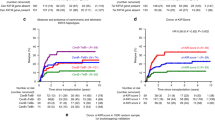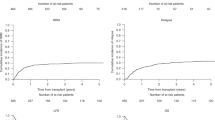Abstract
The reported influence of donor Killer-cell Immunoglobulin-like Receptor (KIR) genes on the outcomes of haematopoietic cell transplantation (HCT) are contradictory, in part due to diversity of disease, donor sources, era and conditioning regimens within and between different studies. Here, we describe the results of a retrospective clinical analysis establishing the effect of donor KIR motifs on the outcomes of 119 HLA-matched, unrelated donor HCT for adult acute myeloid leukaemia (AML) using myeloablative conditioning (MAC) in a predominantly T-cell deplete (TCD) cohort. We observed that HCT involving donors with at least one KIR B haplotype were more likely to result in non-relapse mortality (NRM) than HCT involving donors with two KIR A haplotypes (p = 0.019). Upon separation of KIR haplotypes into their centromeric (Cen) and telomeric (Tel) motif structures, we demonstrated that the Cen-B motif was largely responsible for this effect (p = 0.001). When the cause of NRM was investigated further, infection was the dominant cause of death (p = 0.006). No evidence correlating donor KIR B haplotype with relapse risk was observed. The results from this analysis confirm previous findings in the unrelated, TCD, MAC transplant setting and imply a protective role for donor-encoded Cen-A motifs against infection in allogeneic HCT recipients.
This is a preview of subscription content, access via your institution
Access options
Subscribe to this journal
Receive 12 print issues and online access
$259.00 per year
only $21.58 per issue
Buy this article
- Purchase on Springer Link
- Instant access to full article PDF
Prices may be subject to local taxes which are calculated during checkout



Similar content being viewed by others
References
Mohty M. Acute myeloid leukaemia. In: Apperley JF, Carreras E, Gluckman E, Masszi T, editors. The EBMT handbook on haematopoietic stem cell transplantation, 6th edn. Genoa: Forum Service Editore; 2012. p. 316–29.
Crivello P, Zito L, Sizzano F, Zino E, Maiers M, Mulder A, et al. The impact of amino acid variability on alloreactivity defines a functional distance predictive of permissive HLA-DPB1 mismatches in hematopoietic stem cell transplantation. Biol Blood Marrow Transpl. 2015;21:233–41. https://doi.org/10.1016/j.bbmt.2014.10.017.
Lee SJ, Klein J, Haagenson M, Baxter-Lowe LA, Confer DL, Eapen M, et al. High-resolution donor-recipient HLA matching contributes to the success of unrelated donor marrow transplantation. Blood. 2007;110:4576–83. https://doi.org/10.1182/blood-2007-06-097386.
Shaw BE, Mayor NP, Szydlo RM, Bultitude WP, Anthias C, Kirkland K, et al. Recipient/donor HLA and CMV matching in recipients of T-cell-depleted unrelated donor haematopoietic cell transplants. Bone Marrow Transpl. 2017;52:717–25. https://doi.org/10.1038/bmt.2016.352.
Fleischhauer K, Shaw BE, Gooley T, Malkki M, Bardy P, Bignon JD, et al. Effect of T-cell-epitope matching at HLA-DPB1 in recipients of unrelated-donor haemopoietic-cell transplantation: a retrospective study. Lancet Oncol. 2012;13:366–74. https://doi.org/10.1016/S1470-2045(12)70004-9.
D’Souza A, Fretham C. Current Uses and Outcomes of Hematopoietic Cell Transplantation (HCT): CIBMTR Summary Slides, 2019. Available at https://www.cibmtr.org. Accessed 10 Mar 2020.
Shaw BE, Logan BR, Spellman SR, Marsh SGE, Robinson J, Pidala J, et al. Development of an unrelated donor selection score predictive of survival after hct: donor age matters most. Biol Blood Marrow Transpl. 2018;24:1049–56. https://doi.org/10.1016/j.bbmt.2018.02.006.
Kollman C, Spellman SR, Zhang MJ, Hassebroek A, Anasetti C, Antin JH, et al. The effect of donor characteristics on survival after unrelated donor transplantation for hematologic malignancy. Blood. 2016;127:260–7. https://doi.org/10.1182/blood-2015-08-663823.
Vierra-Green C, Roe D, Jayaraman J, Trowsdale J, Traherne J, Kuang R, et al. Estimating KIR haplotype frequencies on a cohort of 10,000 individuals: a comprehensive study on population variations, typing resolutions, and reference haplotypes. PLoS ONE. 2016;11:e0163973. https://doi.org/10.1371/journal.pone.0163973.
Cooley S, Weisdorf DJ, Guethlein LA, Klein JP, Wang T, Le CT, et al. Donor selection for natural killer cell receptor genes leads to superior survival after unrelated transplantation for acute myelogenous leukemia. Blood. 2010;116:2411–9. https://doi.org/10.1182/blood-2010-05-283051.
Ruggeri L, Capanni M, Casucci M, Volpi I, Tosti A, Perruccio K, et al. Role of natural killer cell alloreactivity in HLA-mismatched hematopoietic stem cell transplantation. Blood. 1999;94:333–9.
Ruggeri L, Capanni M, Urbani E, Perruccio K, Shlomchik WD, Tosti A, et al. Effectiveness of donor natural killer cell alloreactivity in mismatched hematopoietic transplants. Science. 2002;295:2097–2100. https://doi.org/10.1126/science.1068440.
Giebel S, Locatelli F, Lamparelli T, Velardi A, Davies S, Frumento G, et al. Survival advantage with KIR ligand incompatibility in hematopoietic stem cell transplantation from unrelated donors. Blood. 2003;102:814–9. https://doi.org/10.1182/blood-2003-01-0091.
Mancusi A, Ruggeri L, Urbani E, Pierini A, Massei MS, Carotti A, et al. Haploidentical hematopoietic transplantation from KIR ligand-mismatched donors with activating KIRs reduces nonrelapse mortality. Blood. 2015;125:3173–82. https://doi.org/10.1182/blood-2014-09-599993.
Kroger N, Shaw B, Iacobelli S, Zabelina T, Peggs K, Shimoni A, et al. Comparison between antithymocyte globulin and alemtuzumab and the possible impact of KIR-ligand mismatch after dose-reduced conditioning and unrelated stem cell transplantation in patients with multiple myeloma. Br J Haematol. 2005;129:631–43. https://doi.org/10.1111/j.1365-2141.2005.05513.x.
Schaffer M, Malmberg KJ, Ringden O, Ljunggren HG, Remberger M. Increased infection-related mortality in KIR-ligand-mismatched unrelated allogeneic hematopoietic stem-cell transplantation. Transplantation. 2004;78:1081–5.
Kroger N, Binder T, Zabelina T, Wolschke C, Schieder H, Renges H, et al. Low number of donor activating killer immunoglobulin-like receptors (KIR) genes but not KIR-ligand mismatch prevents relapse and improves disease-free survival in leukemia patients after in vivo T-cell depleted unrelated stem cell transplantation. Transplantation. 2006;82:1024–30. https://doi.org/10.1097/01.tp.0000235859.24513.43.
Sobecks RM, Wang T, Askar M, Gallagher MM, Haagenson M, Spellman S, et al. Impact of KIR and HLA genotypes on outcomes after reduced-intensity conditioning hematopoietic cell transplantation. Biol Blood Marrow Transpl. 2015;21:1589–96. https://doi.org/10.1016/j.bbmt.2015.05.002.
Kanga U, Mourya M, Seth T, George J, Sood P, Sharma R, et al. Role of killer immunoglobulin-like receptor-ligand interactions in human leukocyte antigen-matched sibling hematopoietic stem cell transplantation. Transpl Proc. 2012;44:919–21. https://doi.org/10.1016/j.transproceed.2012.03.036.
Venstrom JM, Pittari G, Gooley TA, Chewning JH, Spellman S, Haagenson M, et al. HLA-C-dependent prevention of leukemia relapse by donor activating KIR2DS1. N Engl J Med. 2012;367:805–16. https://doi.org/10.1056/NEJMoa1200503.
Park S, Kim K, Jang JH, Kim SJ, Kim WS, Kang ES, et al. KIR alloreactivity based on the receptor-ligand model is associated with improved clinical outcomes of allogeneic hematopoietic stem cell transplantation: result of single center prospective study. Hum Immunol. 2015;76:636–43. https://doi.org/10.1016/j.humimm.2015.09.009.
Leung W, Iyengar R, Turner V, Lang P, Bader P, Conn P, et al. Determinants of antileukemia effects of allogeneic NK cells. J Immunol. 2004;172:644–50.
Neuchel C, Furst D, Niederwieser D, Bunjes D, Tsamadou C, Wulf G, et al. Impact of donor activating KIR genes on HSCT outcome in C1-Ligand negative myeloid disease patients transplanted with unrelated donors-a retrospective study. PLoS ONE. 2017;12:e0169512. https://doi.org/10.1371/journal.pone.0169512.
Cooley S, Trachtenberg E, Bergemann TL, Saeteurn K, Klein J, Le CT, et al. Donors with group B KIR haplotypes improve relapse-free survival after unrelated hematopoietic cell transplantation for acute myelogenous leukemia. Blood. 2009;113:726–32. https://doi.org/10.1182/blood-2008-07-171926.
Cooley S, Weisdorf DJ, Guethlein LA, Klein JP, Wang T, Marsh SGE, et al. Donor killer cell Ig-like receptor B haplotypes, recipient HLA-C1, and HLA-C mismatch enhance the clinical benefit of unrelated transplantation for acute myelogenous leukemia. J Immunol. 2014;192:4592–4600. https://doi.org/10.4049/jimmunol.1302517.
Mayor NP, Hayhurst JD, Turner TR, Szydlo RM, Shaw BE, Bultitude WP, et al. Recipients receiving better HLA-matched hematopoietic cell transplantation grafts, uncovered by a novel HLA typing method, have superior survival: a retrospective study. Biol Blood Marrow Transpl. 2019;25:443–50. https://doi.org/10.1016/j.bbmt.2018.12.768.
Miller SA, Dykes DD, Polesky HF. A simple salting out procedure for extracting DNA from human nucleated cells. Nucleic Acids Res. 1988;16:1215.
Vilches C, Castano J, Gomez-Lozano N, Estefania E. Facilitation of KIR genotyping by a PCR-SSP method that amplifies short DNA fragments. Tissue Antigen. 2007;70:415–22. https://doi.org/10.1111/j.1399-0039.2007.00923.x.
Kaplan EL, Meier P. Nonparametric estimation from incomplete observations. J Am Stat Assoc. 1958;53:457–81. https://doi.org/10.1080/01621459.1958.10501452.
Cox DR. Regression models and life-tables. J R Stat Soc Ser B (Methodol). 1972;34:187–220.
Gray RJ. A class of K-sample tests for comparing the cumulative incidence of a competing risk. Ann Stat. 1988;16:1141–54.
Fine JP, Gray RJ. A proportional hazards model for the subdistribution of a competing risk. J Am Stat Assoc. 1999;94:496–509. https://doi.org/10.1080/01621459.1999.10474144.
Cooley S, McCullar V, Wangen R, Bergemann TL, Spellman S, Weisdorf DJ, et al. KIR reconstitution is altered by T cells in the graft and correlates with clinical outcomes after unrelated donor transplantation. Blood. 2005;106:4370–6. https://doi.org/10.1182/blood-2005-04-1644.
Smith LE, Olszewski MA, Georgoudaki AM, Wagner AK, Hagglof T, Karlsson MC, et al. Sensitivity of dendritic cells to NK-mediated lysis depends on the inflammatory environment and is modulated by CD54/CD226-driven interactions. J Leukoc Biol. 2016;100:781–9. https://doi.org/10.1189/jlb.3A0615-271RR.
Zaia JA, Sun JY, Gallez-Hawkins GM, Thao L, Oki A, Lacey SF, et al. The effect of single and combined activating killer immunoglobulin-like receptor genotypes on cytomegalovirus infection and immunity after hematopoietic cell transplantation. Biol Blood Marrow Transpl. 2009;15:315–25. https://doi.org/10.1016/j.bbmt.2008.11.030.
Tomasec P, Braud VM, Rickards C, Powell MB, McSharry BP, Gadola S, et al. Surface expression of HLA-E, an inhibitor of natural killer cells, enhanced by human cytomegalovirus gpUL40. Science. 2000;287:1031.
Welte SA, Sinzger C, Lutz SZ, Singh-Jasuja H, Sampaio KL, Eknigk U, et al. Selective intracellular retention of virally induced NKG2D ligands by the human cytomegalovirus UL16 glycoprotein. Eur J Immunol. 2003;33:194–203. https://doi.org/10.1002/immu.200390022.
Halenius A, Hauka S, Dolken L, Stindt J, Reinhard H, Wiek C, et al. Human cytomegalovirus disrupts the major histocompatibility complex class I peptide-loading complex and inhibits tapasin gene transcription. J Virol. 2011;85:3473–85. https://doi.org/10.1128/JVI.01923-10.
Ljunggren HG, Karre K. In search of the ‘missing self’: MHC molecules and NK cell recognition. Immunol Today. 1990;11:237–44.
Frazier WR, Steiner N, Hou L, Dakshanamurthy S, Hurley CK. Allelic variation in KIR2DL3 generates a KIR2DL2-like receptor with increased binding to its HLA-C ligand. J Immunol. 2013;190:6198–208. https://doi.org/10.4049/jimmunol.1300464.
Bari R, Thapa R, Bao J, Li Y, Zheng J, Leung W. KIR2DL2/2DL3-E(35) alleles are functionally stronger than -Q(35) alleles. Sci Rep. 2016;6:23689. https://doi.org/10.1038/srep23689.
Fischer JC, Ottinger H, Ferencik S, Sribar M, Punzel M, Beelen DW, et al. Relevance of C1 and C2 epitopes for hemopoietic stem cell transplantation: role for sequential acquisition of HLA-C-specific inhibitory killer Ig-like receptor. J Immunol. 2007;178:3918–23.
Khakoo SI, Thio CL, Martin MP, Brooks CR, Gao X, Astemborski J, et al. HLA and NK cell inhibitory receptor genes in resolving hepatitis C virus infection. Science. 2004;305:872–4. https://doi.org/10.1126/science.1097670.
Vidal-Castineira JR, Lopez-Vazquez A, Diaz-Pena R, Alonso-Arias R, Martinez-Borra J, Perez R, et al. Effect of killer immunoglobulin-like receptors in the response to combined treatment in patients with chronic hepatitis C virus infection. J Virol. 2010;84:475–81. https://doi.org/10.1128/JVI.01285-09.
Fauriat C, Ivarsson MA, Ljunggren HG, Malmberg KJ, Michaelsson J. Education of human natural killer cells by activating killer cell immunoglobulin-like receptors. Blood. 2010;115:1166–74. https://doi.org/10.1182/blood-2009-09-245746.
Bultitude WP, Gymer AW, Robinson J, Anthias C, Potter MN, Russell NH, et al. The effect of donor KIR2DL1 allelic diversity on the outcomes of HSCT is influenced by conditioning regimen. HLA. 2019;94:122–3.
Acknowledgements
This project was supported in part by funding provided by the National Institutes of Health (NIH, P01-CA-111412) whilst further funding and support was provided by Anthony Nolan.
Author information
Authors and Affiliations
Corresponding author
Ethics declarations
Conflict of interest
The authors declare that they have no conflict of interest.
Additional information
Publisher’s note Springer Nature remains neutral with regard to jurisdictional claims in published maps and institutional affiliations.
Rights and permissions
About this article
Cite this article
Bultitude, W.P., Schellekens, J., Szydlo, R.M. et al. Presence of donor-encoded centromeric KIR B content increases the risk of infectious mortality in recipients of myeloablative, T-cell deplete, HLA-matched HCT to treat AML. Bone Marrow Transplant 55, 1975–1984 (2020). https://doi.org/10.1038/s41409-020-0858-9
Received:
Revised:
Accepted:
Published:
Issue Date:
DOI: https://doi.org/10.1038/s41409-020-0858-9



